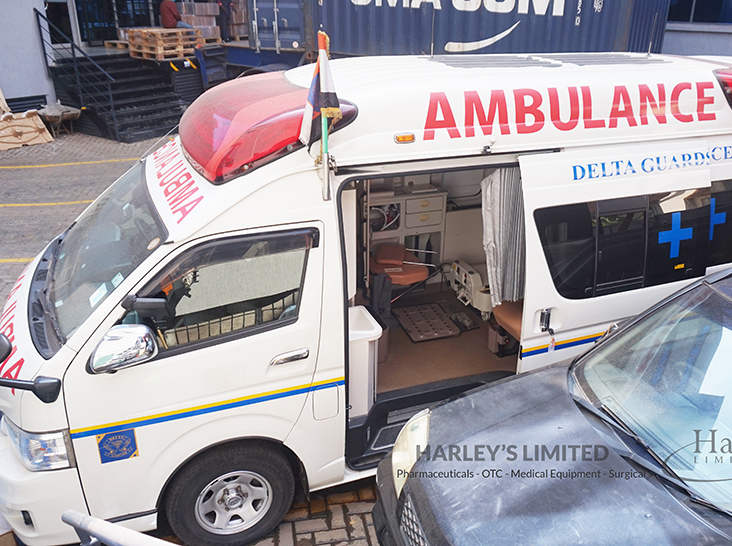The structural components of the ambulance body – the supporting struts, braces, and brackets for the floor, sides, and roof—are either bent to shape using standard machine shop tools or are cut from specially shaped aluminum extrusions that have been purchased from suppliers. The components are held in the proper position and are welded together to form the body frame-work.
The exterior body pieces are fabricated using standard sheet metals and are fastened to the outside of the framework using either mechanical fasteners or adhesive bonding. The external compartments are fabricated and welded in place. Finally, the external body doors are fabricated and are fastened in place on hinges.
The outside of the body shell is then cleaned, sanded, and spray painted with a primer. Next, a sealer is applied. This is followed by a base coat of paint, usually white, and then a clear coat of paint to protect the base color and give the surface a shiny appearance. Between each coat, the body is placed in an oven to dry.
[ngg src=”galleries” ids=”5″ display=”basic_thumbnail” thumbnail_crop=”0″]Preparing the cab and chassis
Additional wiring is added to the cab, chassis, and engine electrical system to accommodate the warning lights and sirens and to bring power to the body. Additional switches and controls are added to the dash as required. The heating and air conditioning systems must also be modified.
Holes are drilled in the vehicle frame rails and mounting brackets are installed to support the ambulance body. The frame rails may be cut to the proper length for the body.
The electrical wiring in the body walls and ceiling is installed from the inside, and foam panels are bonded in place to provide thermal and noise insulation. With the wiring in place, the exterior lights are mounted and connected, and the exterior latches, grab handles, windows, and other trim pieces are installed.
The oxygen piping and outlets, which are part of the patient life-support system, are installed in the body walls. The vacuum system, which removes blood, saliva, and other body fluids is also installed. Sometimes the ambulance body requires an auxiliary heating and air-conditioning system, it is installed at this time.
With all the systems in place, the interior cabinets are installed and the walls, floors, and ceilings are covered. The electrical power distribution board is installed in a forward compartment of the body and the panel is connected to the cab and chassis electrical wiring. If the ambulance is specified with an inverter, which converts 12 volts direct current from the vehicle batteries into 240 volts alternating current for use with medical equipment, it is also installed at this time.
The components of the mentioned ambulance
X10 Patient monitor
For diagnosis and continuous monitoring of the patient while on transportation.
Nebulizer machine
A machine that turns liquid medicine into a mist. You sit with the machine and breathe in through a connected mouthpiece. Medicine goes into your lungs as you take slow, deep breaths for 10 to 15 minutes. It is easy and pleasant to breathe the medicine into your lungs this way.
Ambulance stretcher
It plays an essential role in these tasks, by facilitating the movement of ill or injured patients who are often incapacitated and unable to walk, sit or stand. The stretcher is also the primary device for securing the patient in the moving ambulance.
Transport ventilator
The ventilator helps to push air into the lungs when you’re not breathing properly, or if you have stopped breathing altogether. The machine is attached to an oxygen cylinder to help you take in oxygen. The paramedic will also be able to adjust the rate and depth of your breathing if it’s necessary.
Ambu bags
If you are struggling to breathe, your paramedic’s priority is to get a steady flow of oxygen into your lungs. A BVM is a device connected to a mask that will be placed over your mouth to provide ventilation.
Suction Machine
A suction machine which is used to remove substances such as blood, saliva, mucus, and vomit from a person’s airway. A portable suction unit can prevent pulmonary aspiration and facilitate breathing.
The Aneroid BP monitor
This manually checks your blood pressure. It has a gauge that you read by looking at a pointer on the dial.
Miscellaneous
In addition to advanced medical equipment, you’ll also find inside an ambulance basic but important items such as blood pressure gauges, stethoscopes, thermometers, medical tapes, flashlights, and blankets, to ensure the paramedics are prepared for almost any situation
(source: Wikipedia and Harleys technical team)

